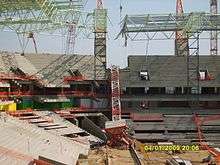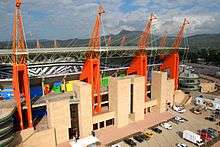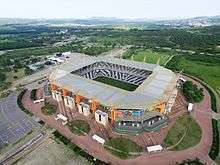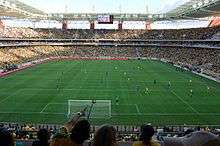Mbombela Stadium
| Africa's Wildest Stadium | |
 | |
 | |
| Location | 1 Bafana Road, Nelspruit |
|---|---|
| Coordinates | 25°27′40″S 30°55′44″E / 25.461°S 30.929°ECoordinates: 25°27′40″S 30°55′44″E / 25.461°S 30.929°E |
| Owner | Mbombela Local Municipality |
| Operator | Platinum Sport |
| Capacity | 40,929[1] |
| Surface | Rye grass & Desso GrassMaster |
| Construction | |
| Broke ground | February 2007 |
| Opened | 15 October 2009 |
| Construction cost |
Rand 1.05 billion (US$ 140 million) |
| Architect | R&L Architects |
| Tenants | |
| Pumas (Currie Cup) (2010-present) | |
The Mbombela Stadium is an all-seater, 40,929-seat stadium and was one of the ten venues[2] for the FIFA World Cup 2010. It is located on open land six kilometres west of Mbombela, South Africa, the capital of the Mpumalanga province.
The stadium has the same name as Nelspruit's new name. In October 2009, Nelspruit was officially renamed Mbombela by the South African government.[3] However, FIFA's 2010 World Cup web site refers to the city as "Nelspruit."
The stadium is the centrepiece of a proposed wider sports precinct with athletics and cricket as well as other sporting codes.
The R1,050-million sports facility was ready for use well ahead of the June 2010 World Cup kickoff. The stadium was made possible through taxpayer funding.
Construction

Construction commenced in February 2007 and was completed in November 2009. The construction contract was awarded to a South African–French consortium of Basil Read Construction and Bouygues Construction.
The structure is founded on 1,500 piles on a 10m structural grid. Each roof support (in the shape of a giraffe) sits on 18 piles on the 30m major structural bay. The 10m span seating beams are prestressed and most of the 3,170 units were pre-cast on site.
The project was subjected to numerous wildcat strikes. With the 5th and final strike, all main contract labourers were dismissed.[4] All subsequent work was performed by subcontractors.
During a freak storm in January 2009, a tower crane blew over and cut through the partially completed roof. The site was unoccupied at the time and there were no injuries.[5] The construction required a total of 5.5 million man-hours to complete.
The site accident history was exceptionally safe with the worst injury being a broken ankle. A record was set of 2.4 million consecutive injury-free hours.
Design
The stadium design reflects its inter-relation with the nearby Kruger National Park. The signature feature of the stadium are the 18 roof supports that resemble giraffes. The seats are patterned with zebra stripes. Visitors to the venue can easily add on a side-trip to the game reserve.

Seating
The bowl design aimed to put every seat as close as practical to the field action and maintain excellent sightlines over the heads of spectators. This venue is the most compact arena of all 2010 venues. Most seats are covered by the cantilever roof.
The seating is divided into 3 tiers with 21,000 lower tier, 3,500 middle tier and 19,000 on the upper tier. The upper tier is accessed by 8 wide ramps located on the corners. The ramps accommodates small delivery vehicles. The middle tier, which is accessed by elevators, has premium seating with a VIP lounge, restaurant, club lounges and 25 private boxes.
Pitch
The pitch is sized for association football(105x68m) and Rugby Union (100x70m). It is floodlit to 2,200 lux to meet FIFA requirements which is on full backup power from diesel generators. The cool season rye grass pitch grown from seed is reinforced with Desso GrassMaster artificial turf fibres which anchor the field, creating what is essentially a semi-synthetic pitch for a stable and a level grass surface and has no problem standing up to extreme abuse during a rugby scrum.
The pitch was the cause of great concern and some ridicule 5 months before the World Cup, but its perfect performance in its first real test on 16 May 2010 silenced the critics.
The selection of rye grass was a directive from FIFA specifically for the World Cup. It an ideal type for the very hot and humid summer conditions. In January 2013 an unfortunate and unusual long spell of unbroken rainy and weather caused a grass fungus which killed off most of the grass in the run-up to the 2013 African Cup of Nations.[6] Concerns were raised over the playing surface[7] with Togo striker Emmanuel Adebayor describing it as "sandy" and "a disgrace". He went on to say "At the end of the day we are all African and we have to be honest with ourselves. It's a beautiful stadium but the pitch is not happening".
Roof

The 1,450 tonne roof covers an area of 22,500 square metres and 94% of the seats. At just 55 kg/sqm [8] it's super lightweight efficient design kept roof cost in check and meant almost all seats are under roof . The roof is 35m above the pitch. Half of the roof is translucent to maximise sunlight to the pitch and to lighten the seating bowl. The roof appears to float above the top of the seating bowl with a 8m gap to provide ventilation in the hot climate and also to provide views to the surrounding hills from the seats.
The structure is a propped cantilever on a 30m module with the steel towers for the tension rods doubling as symbolic giraffe necks. The floor of the service catwalk is 110mm thick concrete acting as ballast to resist wind uplift.
Controversies and corruption
Allegations of corruption relating to the awarding of construction contracts in the building of the stadium plagued the project.[9] At least three individuals were murdered in connection with the allegations, and another three have died under mysterious circumstances.[10]
Murders
The Speaker of the Mbombela Council, Jimmy Mohlala had been a longstanding and vocal critic of corruption in the province. In late 2008 Mohlala began legal steps to cancel the Lefika Emerging Equity design contract for the new stadium on the basis of a fraudulent tax clearance certificate included in their design tender document. He also was opening a criminal case against soccer boss Bobby Motaung for reportedly forging a Mbombela council letter with a fake signature of former Mbombela municipal manager Sgananda Siboza for the purposes of obtaining overdraft from a bank. Shortly after taking these steps, in January 2009, Mohlala was brutally murdered in front of his son outside his residence.[11][12] Allegations have been made repeatedly that Bobby Motaung and David Mabuza organised the murder of Mohlala. David Mabuza was Premier of the Mpumalanga Province at the time and is now Deputy President of South Africa. For more detailed investigative journalistic accounts around his death read the online articles:[13][14][15][16][17].
Mbombela Local Municipality
Corruption related to the construction and general municipal mismanagement resulted in the provincial government taking over the running of the municipality and construction management, by placing the Municipality under administration in June 2007.[18] When the Mbombela Municipality was reinstated 5 months later, the outspoken new mayor Lassie Chiwayo and council officials received death threats, warning them to remain silent about the evidence of corruption.
Lefika Emerging Equity
Lefika Emerging Equity won the design contract for the stadium in April 2006. Lefika was composed of three businessmen. Bobby Motaung, manager of Kaiser Chiefs football club, Herbert Theledi, a businessman with powerful provincial connections, and Chris Grib, a minority shareholder in Lefika and CEO tasked with day-to-day running of the company. Chris Grib left the country in late 2008 under a cloud when it came to light that the SA Revenue Services tax clearance document required to win the design contract was fraudulent.[19] From that time the rest of construction till completion proceeded with Lefika effectively absent, but still earning their professional fees. No officials were brave enough to continue attempts to cancel the design contract.
Fraud Case
Despite their wrong doings being widely reported, Lefika enjoyed political protection by the provincial ANC under the leadership of premier David Mabuza and the Jacob Zuma-faction who suppressed the powerful evidence against Lefika and blocked legal prosecution against them for 3 years.[20] On 15 August 2012 all 3 Lefika directors were arrested for tender fraud related to the stadium's design contract by the special investigations unit, known as the Hawks, an independent national investigations.[21] All 3 were released on bail and returned to court on 15 October 2012. Chris Grib was expected to testify against his co-directors Motaung and Theledi under a plea deal for a lesser sentence, as he was out of the country when Jimmy Mohlala was murdered and when Lefika forged a document on a Municipal letter head used to apply for a R1 million overdraft from Nedbank. Grib was a minority shareholder in Lefika and tasked with day-to-day running of the company. The case was heard but charges later dropped. In January 2016 the case was reinvestigated and the reinstatement of charges was being considered by the National Prosecuting Authority however nothing came of this.[22] By July 2016 the case was struck off the roll due to a lack of evidence among talk of Bobby Motaung initimidating witnesses from testifying.[23] In November 2017 the National Prosecuting Authority announced that the fraud case would no longer be pursued for lack of evidence.[24] The dropping of charges were reportedly due to Zuma-faction members within the NPA ignoring the evidence. [25]
Lowest cost new 2010 stadium

Although the stadium is widely known for above corruption it is ironic that the stadium became a model in terms of lowest total cost. Mbombela Stadium stands out as being the lowest cost new 2010 stadium by quite a large margin and the highest ratio of seats under roof. The worst erroneous spending that has come to light was a very expensive sod turning ceremony costing more than R2 million, and a R590,000 invoice for a business plan that was inflated to R2.4 million by Lefika, with payment forced through by the municipal manager Jacob Dladla. It was reported that an expensive car was purchased as a gift for Dladla at the time. He was arrested on related charges in October 2012 and released on bail.[26]
Lefika arranged a very expensive sod turning ceremony. Attempts by Lefika to manipulate the awarding of stadium construction sub-contracts were successfully blocked by principled officials within the Municipality and the Project Manager.
| STADIUM | Cost | % seats under roof |
|---|---|---|
| Mbombela Stadium | Rand 1.05 billion(USD $ 150 million) | 94% |
| Peter Mokaba Stadium | Rand 1.24 billion(USD $ 165 million) | 28% |
| Nelson Madela Bay Stadium | Rand 2.1 billion(USD $ 280 million) | 69% |
| Soccer City | Rand 3.3 billion(USD $ 440 million) | 66% |
| Moses Mabihda Stadium | Rand 3.4 billion(USD $ 450 million) | 90% |
| Cape Town Stadium | Rand 4.4 billion(USD $ 580 million) | 94% |
Local Community
Promises of improvements to the impoverished surrounding neighborhood have not been fulfilled.[27] Students from the local primary and high schools had to be relocated to container classrooms and the old schools used by the General Contractor. It took multiple violent protests to get the authorities to finally build the new schools 3 years after they were promised.[28] The land belonging to the Matsafeni trust was sold for R1 by corrupt community leaders to the Mbombela Local Municipality for the new stadium in exchange for other rights. The sale was set aside 3 years later when the community launched a legal challenge and reinstated with a market related price.[29]
Wetland
To make way for a replacement school, a wetland in Nelspruit was bulldozed, but no environmental impact assessment was done before the wetland was destroyed.
2010 FIFA World Cup
| Date | Time (UTC+2) | Team #1 | Res. | Team #2 | Round | Attendance |
|---|---|---|---|---|---|---|
| 2010-06-16 | 13.30 | 0–1 | Group H | 32,664 | ||
| 2010-06-20 | 16.00 | 1–1 | Group F | 38,229 | ||
| 2010-06-23 | 20.30 | 2–1 | Group D | 37,836 | ||
| 2010-06-25 | 16.00 | 0–3 | Group G | 34,763 |
2013 African Cup of Nations
| Date | Time (UTC+2) | Team #1 | Res. | Team #2 | Round | Attendance |
|---|---|---|---|---|---|---|
| 2013-01-21 | 17.00 | 1–1 | Group C | 15,500 | ||
| 2013-01-21 | 20.00 | 1–1 | Group C | 13,500 | ||
| 2013-01-25 | 17.00 | 1–1 | Group C | 25,000 | ||
| 2013-01-25 | 20.00 | 4–0 | Group C | 35,000 | ||
| 2013-01-29 | 19.00 | 0–0 | Group C | 8,000 | ||
| 2013-01-30 | 18.30 | 1–1 | Group D | 7,500 | ||
| 2013-02-03 | 18.30 | 1–0 (aet) | Quarter-final | 27,000 | ||
| 2013-02-06 | 18.30 | 1–1 (3–2 pen.) | Semi-final | 30,000 |
Football (soccer)

On 16 May 2010, the stadium was officially opened with an international friendly match between South Africa and Thailand. South Africa won 4–0, leading 3–0 at half time.
The stadium was again used by South Africa when they beat Niger 2–0 on 4 September 2010, in a 2012 Africa Cup of Nations qualifier.
On 14 November 2010, the stadium hosted its first Premier Soccer League match. Wits moved their match against Mamelodi Sundowns to the stadium.[30]
Rugby at the Stadium
The Pumas are the main rugby tenants. They will play all Currie Cup matches at the stadium, while most Vodacom Cup matches will be played at Puma Stadium.[31]
The stadium held its first rugby match on 27 August 2010. The Pumas hosted the Blue Bulls in a 2010 Currie Cup match.[32] Pumas won 22–21, trailing 10–11 at half time.[33]
The Pumas made use of the stadium again, when they hosted Western Province on 17 September 2010. Western Province won the match 62-10.
The country's national team, popularly known as the Springboks, played their first match at the stadium against Scotland on 15 June 2013. This match was the second half of a doubleheader, with the curtain-raiser being a matchup between Samoa and Italy. The two composed the second round of a one-off four-team tournament that served partly as a warm-up for the Boks' 2013 Rugby Championship campaign.
South Africa will host Wales at the stadium on 21 June 2014 in the second test of Wales' 2014 South African tour.[34]
See also
References
- ↑ "Mbombela Stadium: the stadiums for the 2010 FIFA World Cup South Africa". FIFA.com. Archived from the original on 26 August 2011. Retrieved 2011-12-02.
- ↑ "FIFA.com – A guide to all the stadiums to be used at the 2010 FIFA World Cup South Africa". FIFA.com. Archived from the original on 30 November 2011. Retrieved 2011-12-02.
- ↑ "BusinessDay – Mashatile postpones name changes after 'technicality'". BusinessDay. Retrieved 2010-06-11.
- ↑ "2010 stadium staff fired". Times LIVE. 2009-09-01. Retrieved 2010-05-18.
- ↑ "Storm causes crane to collapse: News24: South Africa: News". News24. 2009-01-06. Retrieved 2010-05-18.
- ↑ http://www.sabc.co.za/news/a/3ede17804e832210b41dfe7da4cd6ad7/MbombelaundefinedStadiumundefinedpitchundefinedunderundefinedspotlight-20131102
- ↑ http://www.dailymail.co.uk/sport/football/article-2271322/Africa-Cup-Nations-Emmanuel-Adebayor-calls-Mbombela-Stadium-pitch-Nelspruit-disgrace.html Adebayor tears into Africa Cup of Nations semi-final pitch
- ↑ "Mbombela Stadium, South Africa - Mott MacDonald". www.mottmac.com. Retrieved 2018-06-17.
- ↑ Bearak, Barry (2010-03-12). "Cost of Stadium Reveals Tensions in South Africa". The New York Times.
- ↑ "Scandal of SA's 'giraffe stadium'". BBC News. 2010-06-07.
- ↑ "Widow of murdered World Cup whistle-blower slams 'Fifa corruption'". Mail Online. Retrieved 2018-06-17.
- ↑ "Who killed Jimmy Mohlala?". Retrieved 2018-06-17.
- ↑ "Mabuza opens case against those saying he's an assassin". Retrieved 2018-08-14.
- ↑ "Archived copy". Archived from the original on 27 January 2013. Retrieved 26 April 2013.
- ↑ "Archived copy". Archived from the original on 10 June 2016. Retrieved 2016-05-27.
- ↑ "Jimmy Mohlala, World Cup Whistleblower, Shot to Death in South Africa - The Run of Play". www.runofplay.com. Retrieved 2018-06-17.
- ↑ "SACP demands answers on Jimmy Mohlala assassination". News24. Retrieved 2018-06-17.
- ↑ 2010 World Cup whistle-blower shot dead
- ↑ Sindane, Lucky. "2010 big shot skips SA". The M&G Online. Retrieved 2018-06-17.
- ↑ "Police knew about Motaung". News24. Retrieved 2018-06-17.
- ↑ "Chiefs boss faces R143m fraud rap | Pretoria News". Retrieved 2018-06-17.
- ↑ "Bobby Motaung to face the music". CityPress. Retrieved 2018-06-17.
- ↑ "SowetanLIVE". www.sowetanlive.co.za. Retrieved 2018-06-17.
- ↑ "Mbombela Stadium fraud case to be dropped — NPA". CityPress. Retrieved 2018-06-17.
- ↑ "Ntlemeza controls Motaung's fate". CityPress. Retrieved 2018-06-17.
- ↑ "Archived copy". Archived from the original on 30 January 2016. Retrieved 5 March 2012.
- ↑ "In the squalid shadows of SA stadium". BBC News. 2010-06-07.
- ↑ "Archived copy". Archived from the original on 10 August 2016. Retrieved 7 June 2010.
- ↑ http://mg.co.za/article/2010-11-19-missing-documents-stall-mbombela-deal
- ↑ "Wits shift Downs match to Nelspruit". Kickoff.com. 2010-11-05. Retrieved 2010-11-05.
- ↑ "Pumas to play at Mbombela". News24. Retrieved 2018-06-17.
- ↑ "Lowvelder". Lowvelder. Retrieved 2018-06-17.
- ↑ http://supersport.com/rugby/currie-cup/news/100827/Pumas_christen_Mbombela_in_style
- ↑ "Bok 2014 schedule confirmed". Sport. Retrieved 2018-06-17.
External links
| Wikimedia Commons has media related to Mbombela Stadium. |